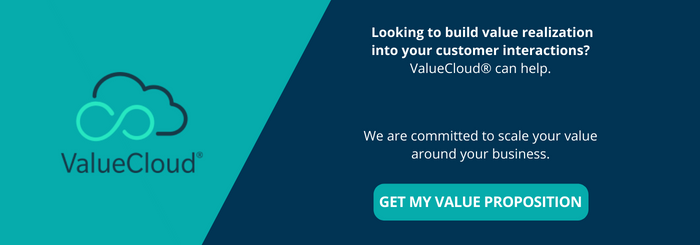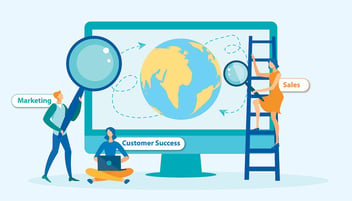Creating Value Across the Customer Journey—Step 1: Driving Adoption

When customers buy your product, they’re doing so because they believe it will add value to their business. How well that value is both communicated and delivered will determine how long your relationship continues—and this applies far beyond the initial prospecting stage and deal closure.
In fact, when sellers continue to emphasize value throughout the customer journey, the value compounds. This serves to strengthen the customer relationship and improve long-term outcomes for both the customer and the sales organization. At DecisionLink, we call this Customer Value Management.
One reason many organizations stall out when scaling conversations around business outcomes across the customer lifecycle is that quantifying that value in a way that’s meaningful to the customer can be incredibly complex, especially when using traditional sales methods. For this reason, the first step in creating value across the customer lifecycle is getting your sellers to adopt a value selling methodology.
Adoption is the beginning of a productive path towards optimizing your business’s bottom line and accelerating value beyond the initial sale—boosting customer satisfaction and renewals. What’s more, it provides a structure around which to build and rally your sales team and sets goalposts that guide future conversations about customer success.
82% of companies report that their customers ask for value analysis that their vendors are unable to provide.
Source: Dimensional Research
As our VP of marketing, Lizzie O’Rourke, explained in a recent DecisionLink webinar, “If you are a seller, the earlier you communicate the value that your company delivers and the more tailored it is to a customer's needs, the faster you have a buyer-seller relationship and collaboration that will carry you through that entire sales cycle.” Adopting a value-centered approach is the entryway to a meaningful dialogue that drives value across the customer journey.
Value selling fills a critical gap
Just like consumers, potential SaaS buyers want to know what they’re getting. They need a grasp on what the product does and confidence that it can solve the challenges they’re facing, but most importantly, they want to understand how the product will benefit their business and outperform other alternatives.
Unfortunately, most buyers are left high and dry. According to Dimensional Research, less than one fifth of companies are able to provide the kind of value analysis their customers want to see. Companies routinely struggle to express the business outcomes their technologies provide because traditional approaches to calculating customer value are manual and extremely difficult to scale.
This situation provides low-hanging fruit for companies that are willing to do the work to give buyers what they want. All they have to do is answer a buyer’s core question:
“Given your understanding of our business challenges, what is the potential business value of your solution for my organization?”
In order to adequately respond to this request, sellers need a way to gain unique insights into the buyer’s business needs, frame the conversation around potential business outcomes, and be able to confidently quantify a value hypothesis. Engaging in this process will persuade buyers to collaborate on a business case, which can then be used to justify investing in the seller’s solution internally.
The key challenge at the adoption stage is to provide a repeatable, trusted framework that sellers can turn to with confidence. Companies that successfully enable their sales teams to lead with conversations around business outcomes and value to the customer put themselves head and shoulders above the competition.
Value selling is a value add
To meet these challenges, businesses must establish a repeatable, scalable, and reliable Customer Value Management process. CVM helps bring companies from less mature, less effective models such as feature and function selling, up to the most sophisticated model: Differentiated Value Selling. In Differentiated Value Selling, value is quantified for a specific project and is compared against other alternative uses of the budget.
Establishing a CVM program to enable Differentiated Value Selling can be a transformative change for an enterprise. Agile CVM positions your company as a trusted advisor to your client, bridging the gap between buyer and seller expectations. Ultimately, this leads to competitive differentiation for your sales and customer success teams.
CVM enables salespeople to challenge the status quo and push for alternative ways to move the needle. No matter how good their people skills, data shapes how your customers see your business. The cold, hard facts of the tangible value you deliver to your customers plays an essential role in their perception of your organization—whether they are a prospect or a long-term customer. Adopting value selling is in itself a value add because it shows that your organization does the work and gets tangible results.
Adopting value selling provides benefits to both buyers and sellers. It fills a critical need for buyers to see the benefits of a product for their organization before they commit, and it differentiates the sellers’ organization from competitors, raising their profile. Adoption of value selling is the first step of a win-win process that ultimately generates happy, satisfied, renewing customers and more money in your pocket.
Embracing a value mindset can help make the adoption of a CVM process less daunting. Download our whitepaper “Why Embracing a Value Mindset is Critical to Long-Term Success” and learn everything you need to know about how a value mindset can start delivering real results for your company.

 ValueCloud
ValueCloud
.png?width=118&height=76&name=Rectangle%20(3).png) ValueCloud Ignite
ValueCloud Ignite
.png?width=92&height=92&name=Rectangle%20(4).png) Free Assessment
Free Assessment
.png?width=100&height=100&name=Rectangle%20(5).png) Watch a Demo
Watch a Demo
.png?width=82&height=96&name=Rectangle%20(6).png) Value Calculator
Value Calculator

.png?width=62&height=51&name=Group%2010%20(1).png) Marketing
Marketing
 Sales
Sales
 Customer Success
Customer Success
 Engage Prospects
Engage Prospects
 Win Deals Faster
Win Deals Faster
 Retain Customers
Retain Customers
.png?width=62&height=62&name=Rectangle%20(8).png) Adopt and Scale
Adopt and Scale
.png?width=54&height=54&name=Rectangle%20(9).png) Cybersecurity
Cybersecurity
 Healthcare
Healthcare
.png?width=54&height=54&name=Rectangle%20(10).png) IT & Software
IT & Software




